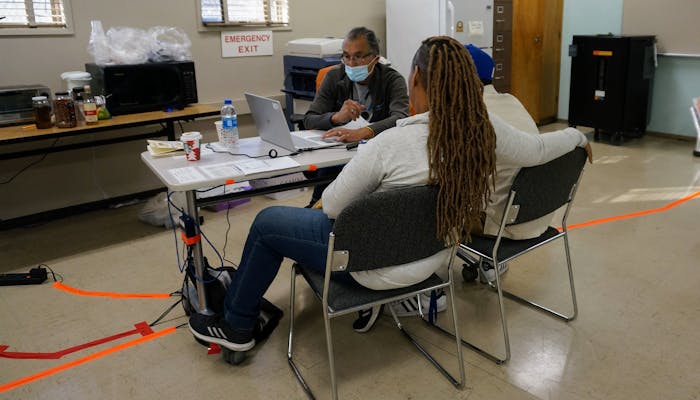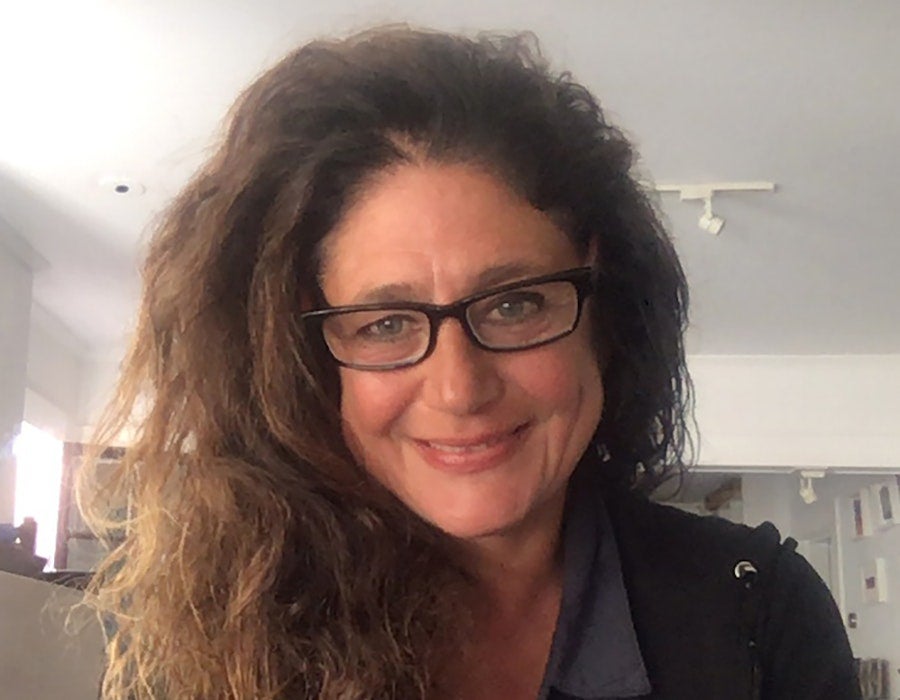Partnership with Relational Medicine Foundation, Saving Hearts Foundation provides funding, equipment, training for EKG exams
UCLA education professor Federica Raia’s research explores how people care for one another – not just about how people say they care, but what they do.
“I want to know what it means to care for another human being,” Raia says.
In her work, she examines how people care for one another in medical and educational situations, engaging students, teachers, patients, and doctors at the crossroads of learning, science, technology and relationships.
On a Saturday in early November, Raia, together with colleagues from the UCLA David Geffen School of Medicine could be found putting research into practice at the Mann UCLA Community School in South Los Angeles, providing healthy heart screenings to about 50 student athletes at the school. The event is part of WeCREATE (Wellness Collaborative for Research & Education Activities to Transform and Empower) an initiative of UCLA School of Education and Information Studies and the UCLA David Geffen School of Medicine . The screening was developed in collaboration with Mann UCLA Community School and the Saving Hearts Foundation, UCLA chapter, who provided Electro Cardio Gram (EKG) Screening to Student Athletes at the school and some of their parents.
UCLA Advanced Heart Failure cardiologists Mario Deng, and Jeff Hsu from the UCLA David Geffen School of Medicine, met and spoke with students about heart health and healthy heart practices, interviewed students about their health background and any symptoms or concerns, and provided students with an EKG exam. For many of the students, if not all, it was the first time they had received an EKG as part of their health care.

“The goal is to educate young members of the community to empower them to take control of their heart health,” said Dr. Hsu. “This is a great young community, and we have the opportunity to impact their trajectory, their health trajectories for the rest of their lives.
“We’re seeing high school students and talking with and educating them about their heart health. We’re asking about any concerning symptoms they may have had, whether it’s during exercise or during their day to day activities, and any family history of any heart disease, heart conditions like diabetes and hypertension, and educating them on what these conditions are. We’re measuring their blood pressure and explaining what their blood pressure means. We’re doing 12 lead electrocardiograms and talking about what we can see on a 12 lead ECG. After making an assessment, then we give them this information, and let them know what this information means.”
The event at Mann UCLA was held in partnership with The Saving Hearts Foundation, which is focused on preventing Sudden Cardiac Arrest (SCA), a top cause of death among student athletes, killing more than 5,000 annually. Sudden Cardiac Arrest, can occur without any visible warning signs or symptoms. The first symptom can be death. Occurrences are more prevalent among students of color, and those from low-income communities.
“Sudden cardiac arrest is a really dangerous thing,” said Andy Shea, a UCLA graduate and now a medical student at UC Irvine, who serves as director of the Foundation. “It’s basically due to abnormalities with the electrical system of the heart that can cause a heart to beat abnormally and can cause an arrest. The only way to really identify warning signs of sudden cardiac arrest, because it’s largely an asymptomatic type of condition, is to do a heart screening including an EKG.”
Many students though lack access to effective heart screenings. By providing students with access to electro cardio exams, the Foundation is helping to identify potential abnormalities that can lead to SCA. If any students are identified with potential problems, they receive an echocardiogram and are referred for any necessary follow-up care or preventive measures. To date, the foundation has provided more than 4,800 exams to student athletes.
The heart screening at Mann UCLA is just the one event in what the partners in WeCREATE envision as they work toward the development of a learning and wellness collaborative with the school.
“The pandemic got in the way for a while, but this is a dream of mine,” Professor Raia said. “The dream is to create a program across grades, across departments, across disciplines that engages the Mann UCLA School at the center. The idea is that the grounds of the school can become the center of a connection with UCLA, with the UCLA Medical School and hospital, and of course, the School of Education and Information Studies.
“WeCREATE is a project we are working on together with the UCLA Horace Mann Community School to develop a wellness center, so to speak for heart health, but also, in a larger sense, healthier lives,” adds Dr. Deng, who has partnered with Raia in the effort. “It’s life style related health, embedded in a community engagement and development concept, and let’s also say political, social, economic factors are being incorporated, embraced and transformed into participant action.”
While the health screening is important, at its heart, the effort is about learning. And, as Raia says, “there is a lot of learning going on.”
First, students participating in the screening get the chance to learn about their own health and the steps they can take to stay healthy. Mia Mollette, a senior who plays basketball and other sports at Mann, was excited and a little relieved to learn her heart health looked perfect, and that she was doing a great job with nutrition and exercise.
Beyond their own health, students are also learning science, studying the respiratory and cardiovascular systems in classes at Mann UCLA. Darlene Tieu, a science teacher, has just started teaching physiology this year. Her class started with the respiratory system at the beginning of the school year and the students are now beginning to study the cardiovascular system.
“It was the second day of my cardiovascular unit and I spent the class doing some basic heart anatomy, showing them the different chambers of the heart, and how the heart pumps blood and how blood is important for getting oxygen to the brain,” Tieu said. “The next day, Dr. Deng comes in and talks with the students. It was a natural segue. The students were so keyed in. It was so awesome to watch them look at these pictures and hear the words that they had just learned the day before, to talk about the atrium, the ventricle, the aorta with this doctor, and to see, ‘Oh, this is for real, there is the heart.’
“And there they were, with a big time heart doctor who has spent his whole life studying the heart and fixing the heart. They were super fascinated by the total artificial heart, but then also talking about heart transplants. And they were asking a lot of questions like, how do you keep someone alive while your cutting out their old heart and transplanting a new heart. I could really see the gears going on in their head about what they were learning,” said Tieu.
“That’s the cool thing about UCLA. To be able to connect my students who live in South LA, to someone who’s at the forefront of their field and have them connect to each other. And Dr. Deng, he’s not just like a heart doctor, he is someone who’s very invested in relationships with people, especially young people. And he framed their conversation around dreaming and creating opportunities and encouraging them, I think that was huge as well.”
But it wasn’t only the Mann UCLA students who were learning. The event was also an opportunity for the UCLA doctors and undergraduate students trained by the Saving Hearts Foundation to perform EKG’s. The representatives of the foundations also get the opportunity learn about the people in the community, and to develop more effective approaches and relationships.
“This is not just serving the community; the community is helping the doctors to learn. Raia says. “We don’t just want to increase numbers of EKG’s, we want to increase the quality of the encounter and build relationships.”
For example, Raia says, the Saving Hearts Foundation is learning how to work in schools and communities like Mann’s, modifying how they present and do the work, how they engage the kids, and how they work with the doctors.
Raia and her colleagues in WeCREATE also see the learning as a force that can inform and generate different projects. For example, in the long run, they envision the school potentially serving as a site for training younger cardiologist to learn to listen, to study how to best engage with community members, to listen to the people in the community before telling them what to do.
And Raia, in her own research and work is learning as well.
“I’m not from here, I’m just learning about this community, but I always wanted to be involved,” Raia said. “And so, I’m learning how to enter and become part of this community, how to build relations, how to listen, how be supportive, how to partner together. It’s constant learning,” she concludes.
